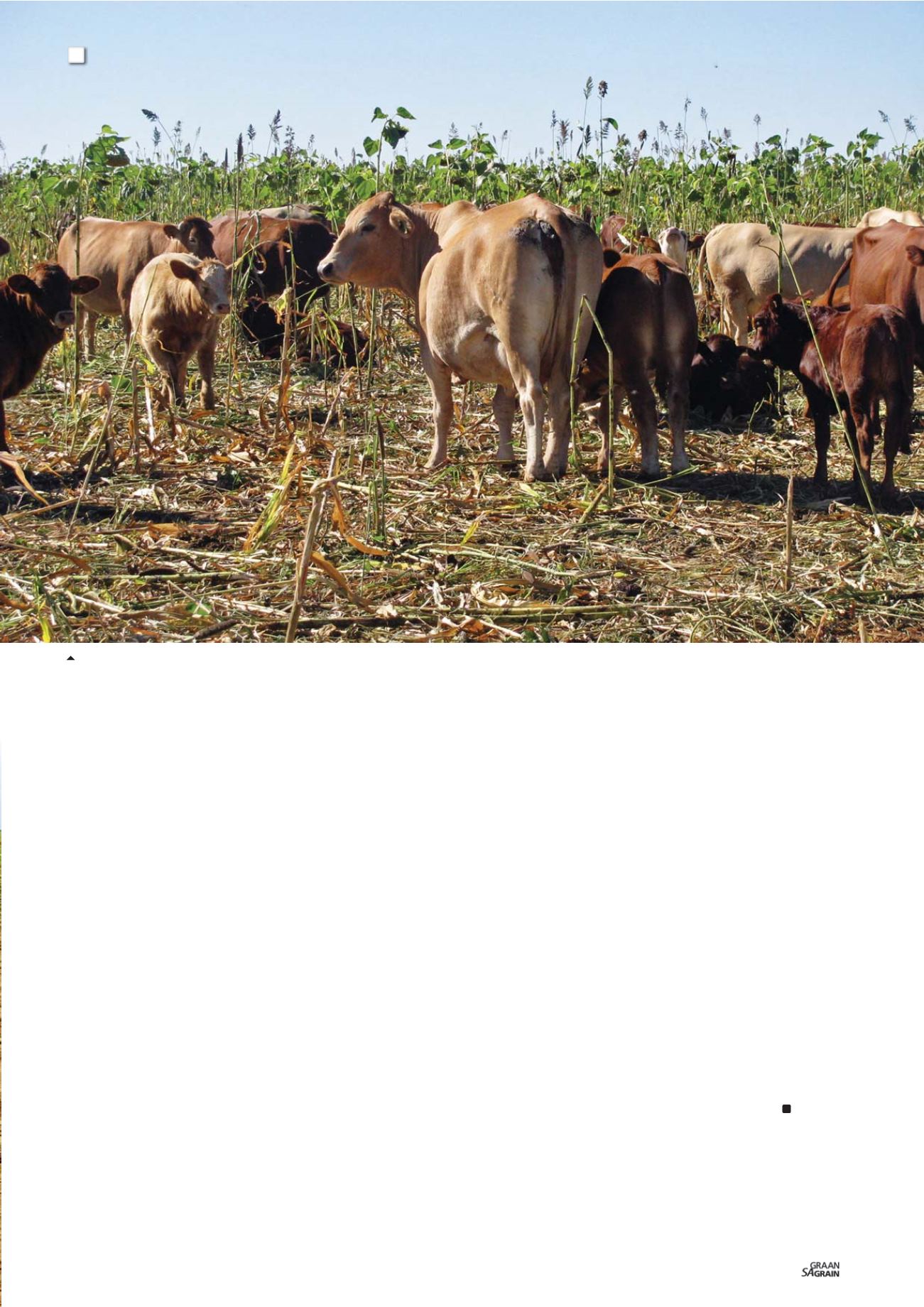

agrochemicals, soil can recuperate with
microorganisms breaking down unwanted
chemical substances.
The practice
At Humanskraal a field trial of 53 ha of a
diverse summer cover crop mixture was
planted, which included grasses, legumes,
cash crops and radish. Two planters were
used to plant the big and fine seed sepa-
rately on the same field. The planting den-
sities for both big and fine seeds were
110 000 seeds/ha. The aim was a total of
220 000 plants/ha.
The fine seeds were planted at a 30˚ an-
gle on top of the big seed rows. The direct
drilling of seed in rows brought a saving on
seed cost of 50%, compared to broadcast-
ing.
Photo 2
is testimony of the successful
establishment of the cover crop. Planting
took place on 16 January this year, whereas
the photo was taken on 1 February.
Grazing
Livestock was bought at an auction at
Vryburg and transported by truck to the
farm Humanskraal of Mr George Steyn
(
Photo 3
). Due to the high prices of weaners
at the time, cow/calf pairs were bought, 200
in total, which equates to 150 livestock units
(LSU), with an estimated dry matter need of
2 034 kg/day.
Electric fencing equipment was used to
divide the field in grazing camps of 3 ha
each. These camps were used for a period
of three days before moving livestock to a
new camp. An inclusion area was also iden-
tified where animals could be put in case of
extended rainy events. A perennial warm
season grass pasture of Smuts finger close
to the cover crop was identified as suitable
for this purpose. Water was supplied at a
central point with a corridor on the side of
the field trial giving livestock access to the
water.
Discussion
The most nutritional leaves and seed
heads were consumed by animals. Most
of the more fibrous stems were trampled.
This created a mulching effect that cover
the soil surface completely as shown in
Photo 3. Meat production was in the order
of 215 kg/ha with a feed conversion ratio
of 10.7:1. A total of 11,4 tons of meat was
produced on 53 ha in 60 days.
Graph 3
on
page 41 gives us a breakdown of the bio-
mass that was produced by the cover crop.
Selling at an auction meant that a 7% com-
mission fee had to be paid to the auctioneer
at the cost of R120 000. Transporting the
livestock also had high cost implications.
According to Steyn, buying livestock at
an auction is risky and you might just
end up buying another producer’s pro-
blem animals.
Using your own animals will be less risky
and will add value to your own livestock,
which made more sense to him. The field
trial will become a monitoring site for future
reference.
Conclusion
Restoring soil organic matter back to natu-
ral levels before tillage started, will not be
easy. However, diversifying crops and live-
stock has certainly shown to speed-up the
biological and recovery process.
Producers are urged to start their own strip
trials, comparing and repeating CA practic-
es discussed in this article over a number
of years. Producers should be innovative,
not relying on recipes, adapting each farm
within its own realities. There is no ‘one size
fits all’.
All CA principles should be implemented
with good quality (minimal soil disturbance,
diversity, mulch, livestock integration, liv-
ing roots), which will help to revive soil life
and to feed and protect them.
References
Lal, R. 2016.
Soil health and carbon management
.
Food and Energy Security 5, 212 - 222.
Montgomery, DR. 2017.
Growing a revolution: Bring-
ing our soil back to life
. Norton and Company: New
York, USA.
Moore-Kucera, J. 2016.
Soil organisms
. Soil Health
Division: NRCS USDA.
43
November 2018
3: Livestock grazing cover crops.
3
















